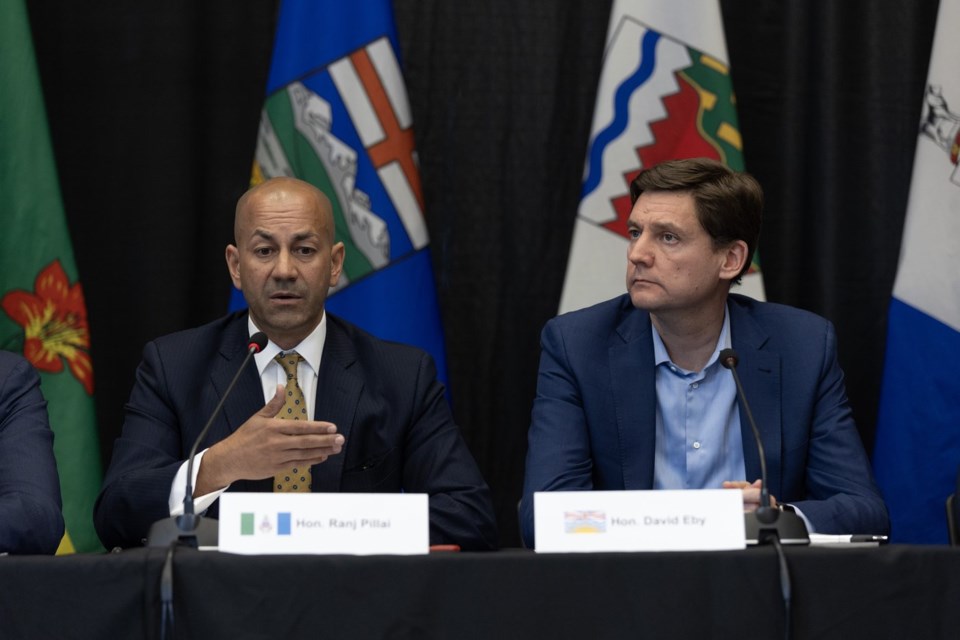Experts say the potential linking of British Columbia's power grid with Yukon would be a game-changer for the territory's quality of life and economy, but realization would likely take more than a decade.
The responses come after B.C. Premier David Eby and Yukon Premier Ranj Pillai last week signed a memorandum of understanding to explore connecting the grids, a move that the jurisdictions said would "strengthen Canadian self-sufficiency, security and resilience" for generations.
University of Calgary professor Jason Donev said Canada's north generally lacks the electricity infrastructure taken for granted in the south, and the lack of cheap, reliable power in many communities weighs on development.
"Everything from food preparation to water purification, access to electricity is a major, major source of quality of life for people," Donev said.
"And this is one of the disparities between what happens in Canada's north and what happens in the south — that things that we take for granted simply aren't taken for granted (there)."
A joint statement issued by B.C. and Yukon last week said the MOU would "guide intergovernmental collaboration through the exploration and planning phases" of linking their power grids.
"The objective … is to address gaps in clean electricity infrastructure that limit the production and expansion of critical mineral resources in Canada by advancing the pre-construction requirements to develop a transmission line and ultimately support critical minerals mining activities in Yukon and northern British Columbia,” the MOU document said.
The statement also said it would be an opportunity to advance reconciliation with First Nations communities associated with the project "through Indigenous partnerships and ownership," along with other means.
The need for First Nations consent and input is among the reasons why a B.C.-Yukon grid link is unlikely to take physical form for more than a decade despite the MOU, said Rosa Brown with clean-energy think tank the Pembina Institute.
Brown said a similar, 1,800-kilometre transmission line project completed in 2024 in northwestern Ontario involving Wataynikaneyap Power showcased how long timelines are to be expected as different levels of government go through the necessary consultations.
"It's definitely, as I understand, a decade plus to sort something like this out," she said. "So yeah, it's more of a long-term project, which does create opportunities for other projects to move forward in the interim — other renewable energy projects to help support the Yukon grid, hopefully."
Brown said a feasibility study a decade ago determined the link was too costly, but fresh factors ranging from Ottawa's higher interest in nation-building projects and increased demand in Yukon for electric heating and vehicles have likely shifted the calculation.
Yukon's power grid does run on renewables such as hydro and wind generation, but Brown said the territory rents a number of diesel generators and also uses liquefied natural gas to support peak periods of power demand — an area that a connected electricity grid would address.
"The expectation is that it would lessen the reliance on the diesel generators and LNG, so it would be a cleaner grid," she said. "And it would also provide more power, allowing for those increased electrification needs."
The University of Calgary's Energy Education website said the closest point where Yukon's grid could connect to B.C. would require at least 900 kilometres of transmission lines as well as a number of intermediate substations.
The project has long been sought by Yukon, and the federal government conditionally approved up to $40 million to look at the possibility of a 765-kilometre transmission line.
Tara Christie, president of mining company Banyan Gold, said while such a link would obviously benefit Yukon's mining developments, the benefits from Arctic sovereignty and quality of life would also be hard to miss.
"We really need to start having big picture vision for some of these important infrastructure projects in Canada," Christie said. "We're pushing to electrification all over Canada without the infrastructure in place to sustain it.
"Yukon's a key example where we have electric cars that are being charged by diesel power generators. It's really important that we start to have this, 'Okay how are we going to actually achieve these goals of electrification and reducing carbon footprint if we don't have the vision to put together a plan to get more power?'"
Christie also said reliable access to large quantity of power would benefit mining industries significantly, including for Banyan's AurMac gold project 356 kilometres north of Whitehorse.
Donev said the remote locations and long distances involved in linking the B.C. and Yukon power grids would likely present "significant engineering and technical challenges," but the project overall makes too much sense to not take shape eventually.
"Oftentimes, access to energy is a major, major barrier … all across the North," he said.
Donev said remote communities often don't have the same economic opportunities because they don't have the same access to electricity.
"More electricity will be available … (and) from a business standpoint, we will see that companies will now be able to engage in activities that they simply couldn't engage in."
This report by The Canadian Press was first published May 26, 2025.
Chuck Chiang, The Canadian Press



